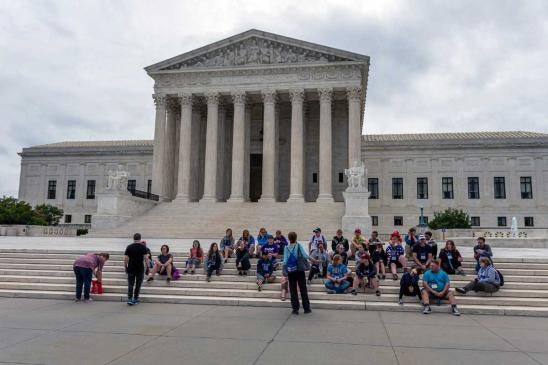This US Supreme Court’s administrative and environmental decisions were somewhat predictable for much of the 2022-2023 term. And then they weren’t – the final weeks of the term especially featured some high-drama decisions.
Coming into the term, we expected to see major decisions in cases including National Pork Producers Council v. Ross, which evaluated the constitutionality of California laws related to pork production and potential effects on the national market, and Sackett v. EPA, which focused on the scope of the Clean Water Act’s (CWA) statutory definition of “waters of the United States.” Below, we discuss those cases and several others which touch on constitutional standing and environmental and administrative law.
While there were small surprises in some of these decisions, most – until the final week of term – were generally predictable and regularly decided on nonpartisan lines. For most of the Court’s term, the decisions were relatively balanced, and the “liberal versus conservative” pattern of last term was perhaps less prominent than it has been in the past. However, in the last week, significant 6-3 decisions, including Students for Fair Admissions v. Harvard (on Affirmative Action), Biden v. Nebraska (on the legality of student loan forgiveness), and 303 Creative v. Elenis (evaluating the legality of a business refusing to make websites for gay weddings), demonstrated a return to partisan splits on the Court.
In the environmental and administrative law space, our key takeaways include:
The Court decided significant cases on the ability of states to act in ways that can affect the national market, the scope of the CWA term “waters of the United States,” the “major questions doctrine” and related clear statement rules, and standing.
While some court decisions appeared to be the products of expected partisan divisions – particularly in the last week – this term’s decisions generally saw varying panels of the Court weighing in.
In terms of what the Court does outside of deciding cases on the merits – granting and denying review – the Court chose to take a case for next term evaluating the continued viability of the Chevron doctrine and declined to review cases related to state climate tort actions and the National Environmental Policy Act (NEPA).
National Pork Producers Council v. Ross
We discussed National Pork in detail here. The case involved a challenge to California’s Proposition 12, which prevents the in-state sale of pork from pigs who are confined in cruel conditions that prevent the pig from “lying down, standing up, fully extending [its] limbs, or turning around freely.” The Supreme Court affirmed the Ninth Circuit’s decision to uphold Proposition 12 and, in doing so, pared back certain limitations on state regulations of all varieties that potentially affect broader markets beyond state lines.
National Pork stands for the proposition that states may have more leeway to pass state-specific environmental or energy laws even if those laws impact out-of-state businesses. This type of state regulation could present businesses with significant obstacles and difficult choices when they wish or need to participate in multiple state markets, but those states have conflicting laws for compliance. This said, state regulations cannot be predicated on a desire to harm out-of-state businesses to the benefit of local ones.
Sackett v. EPA, Nebraska v. Biden, “Clear Statement” Canons, and the “Major Questions Doctrine”
Two decisions – Sackett v. EPA and Nebraska v. Biden – involved big-picture questions on statutory interpretation.
We discussed Sackett v. EPA in detail here. Sackett narrowed the authority of federal agencies to regulate discharges of pollutants into “waters of the United States” (WOTUS) under the Clean Water Act (CWA). In Sackett, the Court held that WOTUS means “streams, oceans, rivers, and lakes” and wetlands that share a “continuous surface connection” with those water bodies. By contrast, the federal government and courts had generally accepted WOTUS to include wetlands “adjacent” (but not necessarily physically connected) to interstate or traditionally navigable waters and their tributaries. As a result of this decision, the US Environmental Protection Agency (EPA) will likely need to issue new rules. Many wetlands that were previously regulated may now be outside the agency’s jurisdiction. Absent new legislation, the primary role of protecting many wetlands will fall back to individual states.
Beyond the CWA, Sackett is an important administrative law decision for its discussion of “clear statement” rules.
EPA had asked the Court to defer to its most recent WOTUS rule interpreting the CWA to extend to certain wetlands possessing a “significant nexus” to traditional navigable waters. The Court declined to do so and reasoned that “exceedingly clear” statutory language is required if Congress wishes to alter the federal-state balance or the federal government’s power over private property. It found that the CWA contained no “clear statement” from Congress to support EPA’s interpretation as the CWA never mentions the “significant nexus” test. Going forward, the Sackett decision may act to further subvert the role of Chevron deference — the doctrine that historically has required a federal court to defer to an agency’s reasonable interpretation of an ambiguous statute — and may put the burden back on Congress if it wishes to expand or adapt the powers of EPA or other federal agencies under now-decades-old environmental statutes.
For the past 15 years, the federal government, a host of courts, and the regulated community relied upon the “significant nexus” test of WOTUS, articulated in Justice Kennedy’s concurring opinion in Rapanos v. United States, as the outer bounds of the CWA’s jurisdiction. But in Sackett, the majority disregarded the Kennedy concurrence in favor of the narrower WOTUS interpretation articulated in Justice Scalia’s four-justice plurality from Rapanos. The Sackett majority added in a footnote that “[n]either party contends that any opinion in Rapanos controls [and] [w]e agree.” Though adherence to precedent is typically central to questions of statutory interpretation, Sackett may be a shot across the bow that precedent – even if it is supported by the executive branch – may not always carry the day.
Biden v. Nebraska, one of two cases evaluating the legality of the Biden Administration’s COVID-related student loan forgiveness plans, referred back to last term’s star interpretive canon, the “major questions doctrine.” (See our discussion here.) In the case, a six-judge majority found that even though the US Secretary of Education may have formalistically complied with statutory requirements to enact a student loan forgiveness program, the Secretary nevertheless lacked authority because the program was so vast in scope — $430 billion in total, potentially affecting nearly all student loan borrowers — and Congress alone has the power to resolve such “major questions.” (Our detailed discussion of Biden v. Nebraska is here.)
As an epilogue, both Sackett and Biden v. Nebraska emphasize that ascertaining the plain meaning of statutes can generate controversy at the Supreme Court level and that disputes over canons of construction continue to percolate before the Court. Finally, the Court will hear Loper Bright v. Raimondo next term, which will address the continuing viability of Chevron deference to administrative agencies. (See here for a detailed discussion.)
Standing Cases
In Haaland v. Brackeen, United States v. Texas, and Biden v. Nebraska the Court analyzed whether states had standing to challenge executive-branch regulatory efforts. (A fourth case – US Department of Education v. Brown – was essentially a companion case to Biden v. Nebraska.) Summaries of standing issues:
Haaland involved a challenge by a birth mother, foster, and adoptive parents, and the State of Texas to the Indian Child Welfare Act (ICWA). In Haaland, while some parties clearly had standing, the Court rejected Texas’s attempts to assert third-party standing on behalf of non-Native American families.
United States v. Texas involved a challenge by Texas and Louisiana to immigration enforcement guidelines promulgated by the Secretary of Homeland Security. Here, because the states were unable to argue that they themselves would be “prosecuted” or “threatened with prosecution,” the Court found that they lacked standing to challenge the guidelines.
Biden v. Nebraska and Department of Education v. Brown involved challenges to the Biden Administration’s efforts to use the HEROES Act to forgive $430 billion in student loan balances. The Biden v. Nebraska plaintiff relevant here was the State of Missouri, whereas the Brown plaintiffs were two persons whose balances had been canceled. Over a three-judge dissent, the Court found that Missouri had standing to sue based on financial losses which could be incurred on behalf of a public entity which was established to service student loans. (See our detailed analysis here.)
Our main standing takeaway from this term is that the Court frequently used standing to limit judicial involvement in policy disputes between states and the federal government. In this regard, Biden v. Nebraska appears to be an outlier where the Court was willing to strain to permit Missouri to have standing, even though an independent state corporation with the capacity to sue or be sued in its own name would also have been a proper plaintiff.
Affirmative Action and Environmental Justice
Non-environmental cases with significant potential for impacting the environmental arena are the companion cases of Students for Fair Admissions v. Harvard and UNC, which are available here. These cases, which involve review of Equal Protection challenges to college admissions policies, were decided 6-3 along partisan lines in favor of race-neutral admissions policies.
We broke down potential environmental impacts to the Students for Free Admissions cases here. Any major impact would likely relate to EPA’s increasing use of authorities granted under federal civil rights laws, including Title VI of the Civil Right Act of 1964, to push state and local governments to more aggressively work to address environmental problems in “environmentally overburdened communities,” which are often poor, nonwhite, and sometimes present because of historic segregation. As we discussed, the Court’s decision striking down affirmative action policies was expected and, even before the decision, EPA took steps to mitigate risk associated with direct consideration of race in the environmental arena related to allocation of federal funding and enforcement.
Gorsuch’s Statement in Arizona v. Mayorkas
A final case worth discussing is Arizona v. Mayorkas, which was dismissed as moot after the government allowed “Title 42 orders” — public health orders issued during COVID-19 — to sunset. The orders were used as part of efforts dating back to the Trump Administration to manage immigration issues along the southern border.
While there is no opinion explaining the dismissal, Justice Neil Gorsuch’s concurring statement decries various executive branch efforts used to manage the COVID crisis. Justice Gorsuch notes that:
The concentration of power in the hands of so few may be efficient and sometimes popular. But it does not tend toward sound government. However wise one person or his advisors may be, that is no substitute for the wisdom of the whole of the American people that can be tapped in the legislative process.
Justice Gorsuch adds that even though Congress had previously “adopted . . . new guardrails in the National Emergencies Act,” it might be time to revisit the vast powers that had been wielded by state and federal executives during COVID so that “emergency decrees [which] promise to solve some problems” do not “generate others. And rule by indefinite emergency edict risks leaving all of us with a shell of a democracy and civil liberties just as hollow.”
Cases Denied Review
Finally, we wanted to mention a few cases the Court chose not to hear:
State Climate Tort Cases. Early this term, the Supreme Court declined to review a number of cases originally filed in state courts against fossil-fuel-associated companies seeking damages related to climate change. The United States opposed court review on the grounds that the complaints presented claims which could be addressed by state courts. Various business interests supported review, given what they perceived to be the essentially federal nature of carbon emissions regulation. As these cases continue in various state courts, we are likely to see some of them make their way to the Supreme Court in the future.
Naturaland Trust v. Dakota Finance LLC. Most environmental statutes contain “citizen enforcement” provisions. Naturaland, originating in the Fourth Circuit, presented the question of whether a pre-litigation regulatory notice of violation (NOV) — something with a degree of formality but short of a lawsuit — could preclude a subsequent CWA citizen suit. After a district court dismissed the Naturaland’s complaint on the grounds that a state regulators were “diligently prosecuting” claims against Dakota Finance, the Fourth Circuit, relying on the CWA statute, found the NOV insufficient to preclude claims over a federalism-focused dissent by a judge who would have barred the claims.
American Petroleum Institute (API) vs. Environmental Defense Center. In a NEPA-related case, API involved review of federal permits permitting fracking in the Pacific Ocean off the California coast. Petitioners sought review of a Ninth Circuit decision allowing permit opponents to challenge a Department of Interior programmatic environmental assessment (EA) and finding of no significant impact, even though the Department had not yet issued any permits related to these documents. Petitioners contended that review of these documents was premature under the Administrative Procedure Act (APA) and other relevant federal statutes. NEPA-related issues are closely associated with both infrastructure development and EJ concerns, and issues like this case presents will continue to arise.





 i
i


